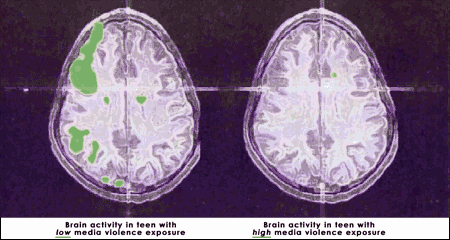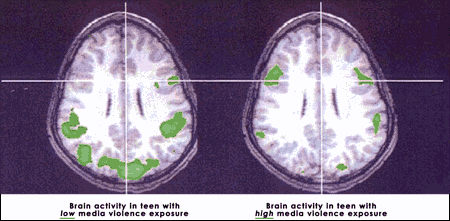
KINGDOM COME MINISTRIES INC WORLDWIDE
Research-Brain Scan
Imagery, Indiana University
School of Medicine
More than 20 years of stop the violence church meetings, town hall meetings, and grassroots surveys have revealed an overwhelming need to expose criminalization of our CYYA through RBE in music/music videos.
In support of our position, we have included content from websites of the American Academy of Child & Adolescent Psychiatry (AACAP); an exceptionally enlightening November 2009 article in Pediatrics, American Academy of Pediatrics Council on Communications and Media (we left the content of their article as is, i.e., their hyperlinks to specified footnotes).
This first set of brain scans shows brain activity during a decision, called Go-No-Go.

When looking into the future, weighing consequences and making decisions, the low media violence exposure group is using a lot of the logical part of their brain; the high media violence exposure group is using very little.

This second set of brain scans show that media violence stunts or "retards" kids' brain development: children with violent TV, movie, and video game exposure had reduced cognitive brain function.
Media violence also makes violent brains: violent TV, movie, and video game exposure had an effect on normal kids that made their brain scans the same as children with documented diagnosed Aggressive Behavior Disorder.
The Indiana University brain study researched groups with exposure to violent pulsations of light--TV, movie, and video games (screen imagery). While the youth in the study were not exposed to silent video games, silent movies, or silent TV programs, the pulsations of light were accompanied by pulsations of sound.
In media where there are simultaneous occurrences of violent imagery and sound, can research make a distinction between damage caused by the violent imagery and damage caused by the violent sound contained in the media? If yes, was that done in this study; and how may the public know the findings?
The scans and information were available on the University of Indiana website, but have been removed. We found nothing about the study in their archives. Contact info for readers desiring to make inquiry: Research Administration Phone: 317-274-2325.
FROM THE AMERICAN ACADEMY OF PEDIATRICS| NOVEMBER 01 2009
Impact of Music, Music Lyrics, and Music Videos on Children and Youth
"...33% of those listening to music did so while performing other tasks or activities. These data support the idea that the prevalence of music-listening in adolescents may be even higher than that of television viewing. The reason for this is that popular music is present almost everywhere, from the supermarket to the mall, often as background music..." Read more
While greater concern and research leans toward violent video games, determined to be school campus murderers preference of media entertainment, studies indicate music-listening to be most prevalent among youth and young adults.
Brain study research data is likewise needed for adolescents who engage in violent audio.
Electrical Pulsations of Light (Imagery) and Sound Encoded with Crime, Murder, and
Mayhem are Recorded on the Cranial Brain, the Heart Brain [1], and Permanently
Stored in the Subconscious Mind of Children, Youth, and Young Adults
